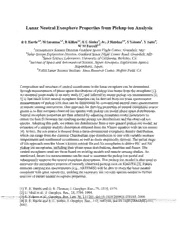
NASA Technical Reports Server (NTRS) 20090038677: Lunar Neutral Exposphere Properties from Pickup Ion Analysis PDF
Preview NASA Technical Reports Server (NTRS) 20090038677: Lunar Neutral Exposphere Properties from Pickup Ion Analysis
Lunar Neutral Exosphere Properties from Pickup ion Analysis R E Hartlel'S, M Sarantosl'S, R Men2'S, E C Sittlerl, Jr., J Halekas3'S, S Yokota ¢, Y Saito¢, W M Farrell2,5 'Heliophysics Science Division Goddard Space Flight Center, Greenbelt, MD 2Solar System Exploration Division, Goddard Space Flight Center Road, Greenbelt, MD 3Space Science Laboratory, University of California, Berkeley, CA ¢Institute of Space and Astronautical Science, Japan Aerospace Exploration Agency, Sagamihara, Japan. 5NASA Lunar Science Institute, Ames Research Center, Moffett Field, CA Composition and structure of neutral constituents in the lunar exosphere can be determined through measurements of phase space distributions of pickup ions borne from the exosphere [1]. An essential point made in an early study [ 1 ] and inferred by recent pickup ion measurements [2, 3] is that much lower neutral exosphere densities can be derived from ion mass spectrometer measurements of pickup ions than can be determined by conventional neutral mass spectrometers or remote sensing instruments. One approach for deriving properties of neutral exospheric source gasses is to first compare observed ion spectra with pickup ion model phase space distributions. Neutral exosphere properties are then inferred by adjusting exosphere model parameters to obtain the best fit between the resulting model pickup ion distributions and the observed ion spectra. Adopting this path, we obtain ion distributions from a new general pickup ion model, an extension of a simpler analytic description obtained from the Vlasov equation with an ion source [4]. In turn, the ion source is formed from a three-dimensional exospheric density distribution, which can range from the classical Chamberlain type distribution to one with variable exobase temperatures and nonthermal constituents as well as those empirically derived. The initial stage of this approach uses the Moon's known neutral He and Na exospheres to derive He+ and Na+ pickup ion exospheres, including their phase space distributions, densities and fluxes. The neutral exospheres used are those based on existing models and remote sensing studies. As mentioned, future ion measurements can be used to constrain the pickup ion model and subsequently improve the neutral exosphere descriptions. The pickup ion model is also used to estimate the exosphere sources of recently observed pickup ions on KAGUYA [3]. Future missions carrying ion spectrometers (e.g., ARTEMIS) will be able to study the lunar neutral exosphere with great sensitivity, yielding the necessary ion velocity spectra needed to further analysis of parent neutral exosphere properties. [ 1 ] R. E. Hartle and G. E. Thomas, J. Geophys. Res., 79, 1519, 1974. [2] U. Mall et al., J. Geophys. Res., 25, 3799, 1998. [3= LLLt^ 241, dot 10.1029r'2009GL03 8185, 2009 [4] R. 2007.
